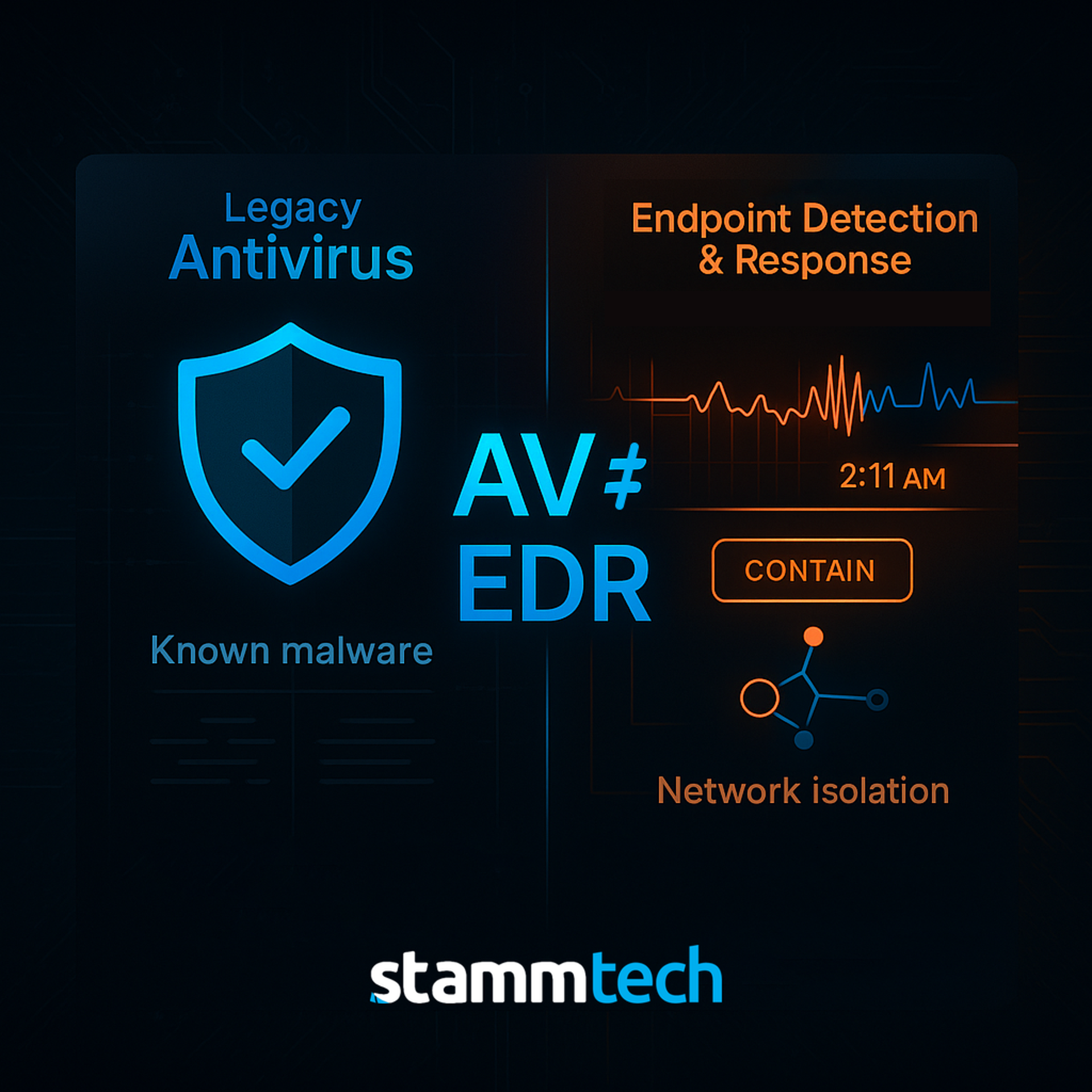TL;DR
- Antivirus (AV) mainly blocks known malware using signatures. EDR adds continuous monitoring, behavioral detection, and response (isolate a device, kill a process, collect forensics). That’s why it catches the weird/new/stealthy stuff AV misses.
- Attackers commonly abuse PowerShell to run malicious commands silently—exactly the kind of behavior EDR can spot and contain.
- Practical win: EDR lets us contain a suspicious PowerShell event at 2:11 AM, before damage spread—using built-in actions like device isolation and investigation packages.
The problem with “We already have antivirus.”
Traditional AV is essential, but it focuses on known threats—malware that already has a signature. Modern attacks evolve quickly, use LOLBins (like PowerShell), and blend in as “normal” admin activity. EDR watches endpoint behavior in real time, correlates events, and gives you push-button response to stop an incident in progress.
What actually happens at 2:11 AM
Hypothetical situation. A client’s endpoint generates an alert for a suspicious PowerShell command outside normal hours. From the EDR console we could isolate the device from the network, capture an investigation package, and review the process tree before it has a chance to laterally move. Those are standard EDR response patterns—not sci-fi.
What “good” looks like (EDR fit checklist)
- Coverage: Agents on all supported Windows/macOS endpoints (servers too)
- Detection: Behavioral analytics for scripting, credential access, persistence
- Response: Isolate device, terminate process, quarantine file, collect evidence
- Visibility: Timeline/process trees, user and network context
- Playbooks: Who triages alerts at 2 AM? When do we isolate vs. uninstall an update? (Document it.)
AV vs. EDR: quick contrast
|
Capability |
Antivirus (AV) |
Endpoint Detection & Response (EDR) |
|
Primary method |
Signatures/known bad |
Behavior + analytics (known & unknown) |
|
Visibility |
Limited |
Full endpoint telemetry & timelines |
|
Response |
Usually quarantine only |
Isolate device, kill process, collect forensics |
|
Threats covered |
Commodity malware |
Fileless, script-based (e.g., PowerShell) & post-exploit actions |
Sources: SentinelOne explainer; Cisco EDR overview; MITRE ATT&CK PowerShell.
Implementation quick start (90 minutes)
- Pilot the EDR agent on IT and a small “power user” group.
- Tune: enable network/device isolation and define alert severities & auto-response rules.
- Playbooks: write who/when/how for isolate vs. investigate vs. reimage (borrow from CISA response playbooks).
- Measure: time-to-detect, time-to-contain, and incident close time.
- Roll out to remaining endpoints; integrate with ticketing for audits.
FAQs
Is EDR a replacement for antivirus?No—think of EDR as AV + visibility + response. Many EDR platforms include AV capabilities, but the win is behavior analytics and push-button remediation.
What specific “response” actions do we get?At minimum: isolate a device from the network, terminate or quarantine suspicious processes/files, and collect investigation packages for forensics. (Microsoft Defender for Endpoint examples.)
Why does everyone mention PowerShell?Because attackers frequently abuse it to execute code and move laterally without dropping obvious binaries. EDR watches for those behaviors and flags anomalies.
We’re a small team. Is EDR overkill?Not anymore. Modern EDR centralizes alerts, automates common actions, and shortens time-to-contain. It’s become table stakes for SMB risk management.
How is EDR different from XDR?EDR focuses on endpoints. XDR fuses telemetry across email, identity, network, and cloud to correlate signals. Many vendors let you start with EDR and expand to XDR later.
Ready to sanity-check your setup?
We’ll run a 2-minute EDR fit check for your environment and show where AV is fine vs. where EDR adds real value.
